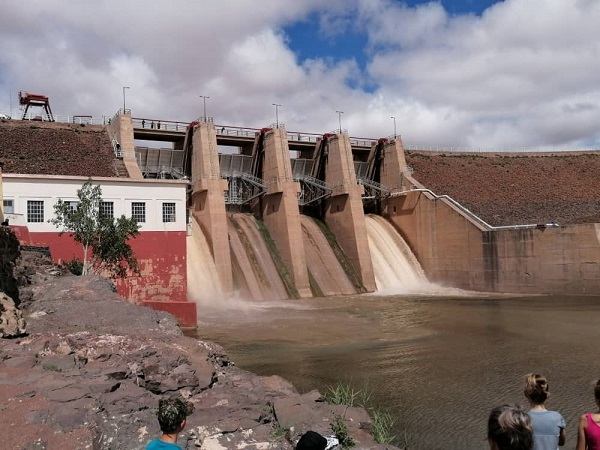
All four Hardap gates opened in anticipation of faster inflow after level reached 70.8%

Following more rain in the Hardap catchment area, the dam’s inflow rate started increasing again around 05:00 on Tuesday morning, 12 January 2020. By 07:00 the dam was 70.5% full, increasing to 70.8% an hour later. A decision was then taken to open two of the sluice gates a fraction, to let out an initial 250 cubic metres per second. The inflow rate was 264 cubic metres per second.
Namwater has continuously monitored the status of Hardap and Naute since the start of the major rain season at the end of December. Early in January, Hardap was only 39% full but this changed rapidly once the inflow picked up substantially on 04 January. The dam’s content quickly increased to around 52% after an inflow rate of more than 570 cubic metres per second was sustained for over 24 hours.
At an inflow rate of 500 m3/s the dam rises about 14% in 24 hours, the Namwater monitoring station at Hardap advised. On 05 January, the dam reached the 56% level but by then the inflow rate has subsided to 201 m3/s. Nevertheless, the Fish River continued flowing strongly recording flood levels at the five monitoring stations at Dirichas, Draaihoek, Gras, Karris and Kub. Namwater then advised that the situation was monitored continuously.
On 07 January Hardap exceeded the 60% mark for the first time this season. With a limited inflow rate of only 68.4 m3/s, the dam level continued to rise but at a much slower rate. After more copious rains at the end of last week and over the weekend, the inflow rate picked up on Sunday 10 January to 129 m3/s and Namwater predicted that the 70% mark will be reached within seven hours. This led the utility to put out a cautionary to all residents in the vicinity of the Fish River below the dam wall.
“The possibility exists that the level might reach 70% and releases might need to start within the next 10 hours,” Namwater advised on Monday 11 January. “Please note that such releases will not exceed 500 m3/s,” a volume which the utility regards as safe for downstream residents.
Starting with a release rate at only 250 m3/s was explained as necessary to flatten the reeds in the riverbed before incrementally pushing up the volume of released water to 500 m3/s.
At 16:00 on Tuesday afternoon all four gates were opened partially pushing the release rate to 500 m3/s.











































